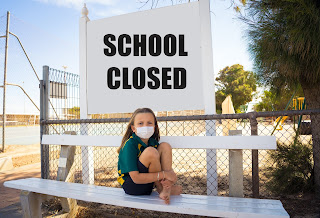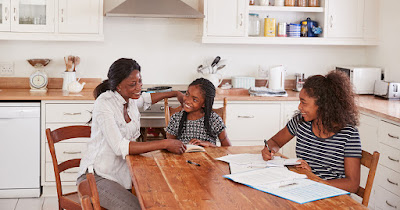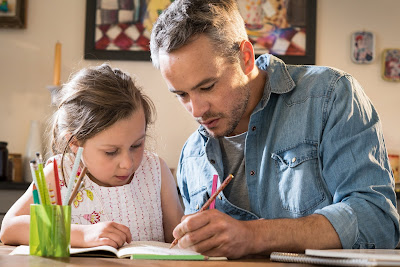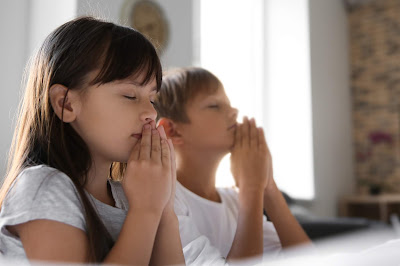Tips for Schooling from Home During COVID-19
Why Pandemic Schooling Is Harder Than Homeschooling –And 14 Tips to Make It Easier
How are you feeling? Are you exhausted, juggling educating the children, keeping those same children entertained, cooking endless meals with limited ingredients, and trying to find toilet paper?
Are you anxious and feeling cooped up, realizing that social distancing is going to last a while—and uneasy because nobody really knows when things will get back to normal?
Here’s a word of wisdom for all of us who aren’t used to homeschooling: You’re not actually homeschooling. You’re schooling at home.
(There’s a difference.)
And if you’re feeling extra stressed, there’s a reason.
Homeschooling vs. Schooling at Home
If you’ve suddenly found yourself schooling at home, you may have Googled, “ways to make homeschooling easier.” And you may have found that homeschooling bloggers keep advising us all to simply “enjoy the time with your children, and just relax.”
What? Relax?!
How? Teachers give online class times, deadlines, and stacks of worksheets. It’s anything but relaxing.
It’s hard.
Well, take heart. This is not the way that homeschooling usually works. This is Pandemic Schooling. And Pandemic Schooling is harder than homeschooling. Way harder.
So realize that what you’re doing is, by design, tough. Take a breath. Here are some truths and tips to help take the pressure off.
Being Together All the Time
Pandemic Schooling means we’re all together—all the time.
With local government stay at home orders to “shelter in place,” we only leave the house for essentials. So our homes are feeling really cramped right about now.
(As much as we love our families, being apart does make the heart grow fonder.)
We’re used to our kids leaving for learning, events, and activities—and that “apartness” gives us breathing room to think, do, and just be.
Without the breathing room, we’re in a pressure cooker.
Here’s the good news:
The new normal of Pandemic Schooling is an opportunity for love. Whether we like it or not, the close-knit pressure cooker gives us so much more time to demonstrate love to each and every member of our families.
(Isn’t love what really matters?)
Sure, it’s hard. Really hard. For all of us. Luckily, there are some “under the wire” ways to take pressure off and make the closeness count for something good.
Try this: Have each child keep a daily gratitude journal. At a meal, give everyone the opportunity to share entries. Encouraging gratitude in these uncertain times can create togetherness… that turns into priceless treasures.
Try this: You, Mama, can keep a daily gratitude journal, too. Don’t forget that your love leads by example.
Calming the Chaos
Chaos, in all of its craziness, just may have become the new norm. As the mom, you’re the leader orchestrating the Pandemic Schooling—the one in the middle of it all.
You can be a part of the storm or the eye of the storm.
Babies cry and need to be changed. Toddlers empty bookshelves. And those school kids? One needs help with math, one wants to know how to spell antiquated, and another needs help logging into the online classroom. Oh—and Dad needs everyone to be quiet during his conference call.
(And everyone needs mom at the same time.)
There’s a reason it’s more chaotic.
With Pandemic Schooling, children who’ve attended “outside school” are used to the rhythm of everyone doing the same thing at the same time. Movement and activities are together, with a group, so transitions and focus are easier.
Not so, with Pandemic Schooling.
Everyone relies on Mom, to keep everyone on track, on task, and moving from one activity to the next.
How can one person do it all?
You can’t. But you can make a plan to do what you can, in the time you have, and in an order that makes sense for everyone.
Older children (which can be defined as, “those who can write”) get to learn to wait—and learn to grow in selflessness.
Try this: Give the older kids a daily task list—a written out “to do” guide to use throughout the day, with jobs of varying difficulty that can be completed independently.
Try this: Grab some Post-it notes and a wipe-off marker, and make a “parking lot” on a window where a child’s non-urgent questions can be “parked.” Number the parking spaces. As a non-critical (but still “real”) need comes up, the child “makes his car” (lists the need on the Post-it) and puts the “car” in the next open “parking spot.” Let the child know that you’ll attend to the questions as soon as you can, in the order that the needs are “parked.”
Working Together
Working together is the goal.
Again—“togetherness” most likely will not be easy. Pandemic Schooling will continue to be one of the most challenging things you’ve ever done—because the family’s not practiced at working together.
But that doesn’t mean working together can’t happen.
Throughout history, children have demonstrated the ability to take on more responsibilities when needed, pitching in during tough times. If you have school-aged children, they’re fully capable of making sandwiches for lunch and keeping the toddler safe for an hour. Really.
Our kids can and should help—and teaching a child about serving the family is teaching how to put love into action.
Many of us juggle multiple online meetings a day, on limited devices. Students who are not used to working independently suddenly have to do so. Of course, everyone’s learning at a different academic level. And the lessons are (also of course) unfamiliar to Mom.
It’s enough to make anyone’s head spin.
Try this: Write down the family’s routines and post it to a wall. Set times on the posted routine for meetings, calls, and even meals. Having the routine posted can set expectations—and put everyone more at ease.
Try this: Get detailed. Don’t simply post, “School time.” Schedule and plan time for independent student work and the work time with Mom. Build in lots of flexibility, allowing for interruptions with “margin time” or white space so, if needed, an activity can flow overtime—or everyone can simply put their feet up and breathe in the white space.
Try this: Make outdoor time a priority. List specific activities and post the list by the door, like “kick the ball into a goal” (targeted area) or “pull dead leaves from between the bushes in the backyard.” Offer “points” that can be cashed in for a dish of ice cream or screen time.
Try this: Gather for prayer. Set family prayer time on your posted routine, and rotate who reads from the Bible or leads the prayer. As a group or individually, come up with specific people and situations to pray for, and let kids pick for whom they’ll pray.
The tough news is this: Even with the most cooperative and capable children and a carefully constructed plan, it’s probably not going to be enough.
(Life during this time simply won’t be like it was.)
Homeschoolers often joke that hoping for a clean house, home-cooked meals, a daily shower, completed schoolwork, and Mom’s sanity is too much to ask, for one day. Adding on, “working from home” and “keeping our family safe from a pandemic,” makes this whole situation exponentially harder.
So be intentional. Choose what appears to be most important each day.
And forgive yourself and others, when intentions don’t pan out.
Seeking Grace
Amidst all of the Pandemic Schooling changes we find ourselves immersed in, humbly looking to God and relying on Him is our saving grace.
We have a hope: by his cross we have been healed and embraced so that nothing and no one can separate us from his redeeming love. In the midst of isolation when we are suffering … let us once again listen to the proclamation that saves us: he is risen and is living by our side. The Lord asks us from his cross to rediscover the life that awaits us … to strengthen, recognize and foster the grace that lives within us.[i]
God’s grace is abundant. His strength will sustain us. And all of these struggles can, if we let them, lead our families closer to the Lord.
When we focus on loving one another and serving together in love, we grow closer to God. Because God is Love.












